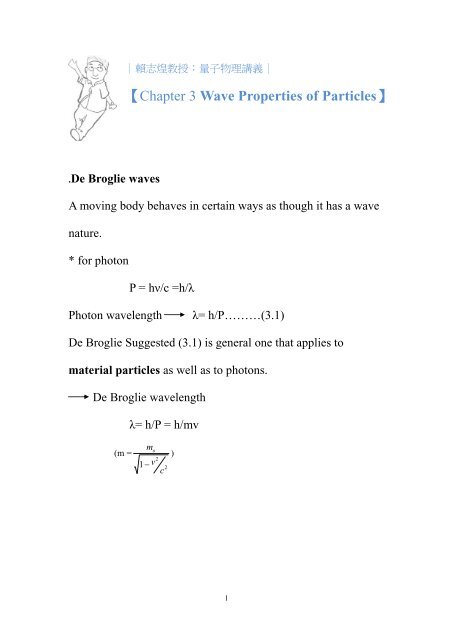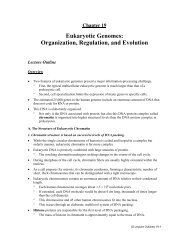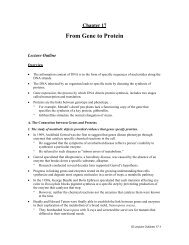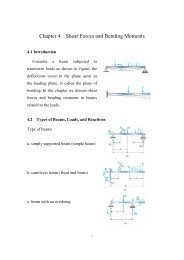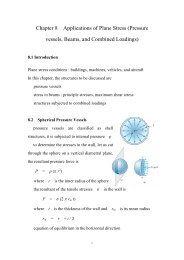for de Broglie waves
for de Broglie waves
for de Broglie waves
You also want an ePaper? Increase the reach of your titles
YUMPU automatically turns print PDFs into web optimized ePapers that Google loves.
| 賴 志 煌 教 授 : 量 子 物 理 講 義 |<br />
【Chapter 3 Wave Properties of Particles】<br />
.De <strong>Broglie</strong> <strong>waves</strong><br />
A moving body behaves in certain ways as though it has a wave<br />
nature.<br />
* <strong>for</strong> photon<br />
P = hν/c =h/λ<br />
Photon wavelength<br />
λ= h/P………(3.1)<br />
De <strong>Broglie</strong> Suggested (3.1) is general one that applies to<br />
material particles as well as to photons.<br />
De <strong>Broglie</strong> wavelength<br />
λ= h/P = h/mv<br />
(m =<br />
m o<br />
2<br />
1<br />
v<br />
c<br />
2<br />
)<br />
1
Example 3.1<br />
Find the <strong>de</strong> Brogli wavelengths of<br />
(a) 46-g golf ball with a v = 30 m/s<br />
(b) e’ with a v = 10 7 m/s<br />
(1) v
【3.2 Waves of probability】<br />
Water wave<br />
Light wave<br />
(varing quantity) height of water surface<br />
E& H fields<br />
How about matter <strong>waves</strong><br />
Wave function Ψ<br />
The value of wave function associated with a moving body at<br />
the particular point x , y, z at time t is related to the likehood<br />
of finding the body there at the time.<br />
*Ψ has no direct physical significance<br />
0 probability 1<br />
but the amplitu<strong>de</strong> of wave am be positive or negative<br />
no negative probability<br />
2<br />
:squae of the absolute value of wave function<br />
probability <strong>de</strong>nsity<br />
** The probability of experimentally finding the body <strong>de</strong>scribed<br />
by the wave functionΨat the point x , y , z at time t is<br />
proportional to<br />
2<br />
there at t.<br />
wave functionΨthat <strong>de</strong>scribed a particle is spread out is spall,<br />
but it does not mean that the particle itself is spread out.<br />
3
【3.3 Describing a wave】<br />
<strong>de</strong> <strong>Broglie</strong> wave velocity v p<br />
v p =νλ(λ=h/mv)<br />
hν=mc 2 ν=mc 2 /h<br />
De <strong>Broglie</strong> phase velocity v p = νλ=(mc 2 /h)(h/mv)=c 2 /v (v =<br />
particle velocity)<br />
Because V
At x=0, y=Acos(2 t) <strong>for</strong> time=t<br />
Figure3.2<br />
Wave propagation.<br />
x = v p t , t =x/v p<br />
y=Acos2 t x/<br />
v )<br />
(<br />
p<br />
the amplitu<strong>de</strong> <strong>for</strong> y(x,t) = y(0,t-x/v p )<br />
v<br />
v<br />
x<br />
y = Acos2 ( vt ) v p = νλ<br />
y =Acos2 ( vt x/<br />
)<br />
p<br />
angular freguency ω= 2πν wave number k= 2π/λ=ω/v p<br />
y = Acos(ωt – kx)<br />
5
Figure3.3<br />
A wave group.<br />
Figure3.4<br />
Beats are produced by the superposition of two <strong>waves</strong> with different frequencies.<br />
6
The amplitu<strong>de</strong> of <strong>de</strong> <strong>Broglie</strong> <strong>waves</strong> →<br />
probability<br />
De <strong>Broglie</strong> wave can not be represented by<br />
y=Acos(wt-kx)<br />
. wave representation of a moving body → wave packet<br />
wave group<br />
. An example is a beat. (two sound <strong>waves</strong> of the same amplitu<strong>de</strong><br />
but slightly different frequencies)<br />
original 440, 442 Hz<br />
hear fluctuating sound of 441 Hz with<br />
2 beats/s<br />
Figure3.5 The Davisson-Germer experiment.<br />
a wave group: superposition of individual <strong>waves</strong> of different λ<br />
which interference with one another<br />
variation in amplitu<strong>de</strong><br />
<strong>de</strong>fine the group shape<br />
7
(1) If the velocities of the <strong>waves</strong> are the same the velocity<br />
of wave group is common phase velocity<br />
(1) If the phase velocity varies with λ<br />
an effect called dispertion<br />
individual <strong>waves</strong> do not proceed together<br />
wave group has a velocity different from the phase<br />
velocities<br />
the case of <strong>de</strong> <strong>Broglie</strong> wave<br />
• group velocity<br />
y 1 = Acos[(ωt –ks)]<br />
y 2 = Acos[(ω+Δω)t – (k+Δk)x]<br />
y =y 1 +y 2<br />
=2Acos1/2[(2ω+Δω)t –(2k+Δk)x]cos1/2(Δωt-Δkx)<br />
because Δω
& of wave number 1/2Δk<br />
Modulation produce wave group<br />
v p =<br />
2<br />
<br />
k 2 <br />
<br />
phase velocity<br />
v g =Δω/Δk = dω/dk group velocity<br />
<strong>for</strong> <strong>de</strong> <strong>Broglie</strong> <strong>waves</strong><br />
2mc<br />
2<br />
<br />
h<br />
2<br />
2<br />
2m oc<br />
<br />
2<br />
h 1<br />
v<br />
c<br />
(because hν=mc 2 )<br />
2<br />
2m<br />
k <br />
h<br />
h<br />
2m v<br />
o<br />
2<br />
1<br />
v<br />
c<br />
2<br />
2<br />
(because λ=h/mv)<br />
* both ω&k are functions of body’s v v g = dω/dk =<br />
d<br />
<br />
dv<br />
h<br />
2m v<br />
o<br />
2<br />
2<br />
1<br />
v 3 2<br />
c<br />
,<br />
dk<br />
dv<br />
h<br />
2m<br />
3<br />
2<br />
1<br />
v 2 2<br />
v g = v (<strong>de</strong> <strong>Broglie</strong> group velocity)<br />
<br />
o<br />
c<br />
d<br />
dv<br />
dk<br />
dv<br />
De <strong>Broglie</strong> wave group associated with a moving body travels<br />
with the same velocity as the body.<br />
De <strong>Broglie</strong> phase velocity v p =ω/k=c 2 /v<br />
v p > velocity of the body v > c<br />
(∵ it is not the motion of the body)<br />
9
Ex 3.3 :<br />
An e' has a <strong>de</strong> <strong>Broglie</strong> wavelength of 2pm=2x10 -12 m.Find its<br />
kinetic energy & the phase & group velocity of its <strong>de</strong> <strong>Broglie</strong><br />
<strong>waves</strong>.<br />
2 2 2<br />
(a) E =E o +kE kE =E – E o = Eo<br />
p c Eo<br />
pc = hc/λ= (4.136x10 -15 ev.s)(3x10 8 m/s)/(2x10 -12 ) =<br />
6.2x10 5 ev=620kv<br />
the rest energy of e' is E o =511kv<br />
2<br />
2<br />
kE= 511 620 511 292 kev<br />
(b) e' velocity<br />
2<br />
Eo<br />
E <br />
E<br />
v c 1<br />
o<br />
2 0. 771c<br />
2<br />
1<br />
v<br />
E<br />
2<br />
c<br />
∴ v p = c 2 /v =1.3c , v g = v = 0.771c<br />
10
3.5 particle diffraction e'-beam diffraction<br />
confirm <strong>de</strong> <strong>Broglie</strong> <strong>waves</strong><br />
Figure3.6 Results of the Davisson-Germer experiment.<br />
The method of plotting is such that the intensity at any angle is<br />
propotional to the distance of the curve at the angle from the<br />
point of scattering.<br />
Figure3.7 The diffraction of the <strong>de</strong> <strong>Broglie</strong> <strong>waves</strong> by the target responsible<br />
<strong>for</strong> the results of Davisson and Germer.<br />
11
nλ=2dsinθ<br />
λ=2dsinθ=0.165nm λ=h/mv=0.166nm<br />
Figure3.8 Because the wavelengths of the fast electrons in an electron microscope are shorter than<br />
those of the light <strong>waves</strong> in an optical microscope can produce sharp images at higher magnifications.<br />
The electron beam in an electron microscope is focused by magnetic fields.<br />
Figure3.9 A particle confined to a box of width L.<br />
12
【3.6 particle in a box】<br />
a prticle trapped in a box = a standing<br />
wave.<br />
Ψmust be zero at the walls<br />
λ n =2L/n n=1,2,3……<br />
De <strong>Broglie</strong> wavelength of trapped<br />
particles.<br />
Figure3.10<br />
Wave functions of a particle trapped in a box L wi<strong>de</strong>.<br />
KE=1/2(mv 2 )=(mv) 2 /2m=h 2 /(λ 2 2m)<br />
∵λ n =2L/n<br />
KE+v=E n the energy <strong>for</strong><br />
13
the particle in a box<br />
E n =n 2 h 2 /8mL 2 →n=1,2,3……..<br />
Each permitted energy is called an<br />
energy level.(n=quantum number)<br />
This can be applied to any particle confined to a certain region<br />
of space.<br />
Figure3.11<br />
Energy levels of an electron confined to a box 0.1nm wi<strong>de</strong>.<br />
14
For example<br />
e -<br />
nucleus<br />
1. Atraped particle cannot have an arbitrary energy, as a free<br />
particle can .<br />
Confinement leads to restriction on its wave function that alloy<br />
the particle to have certain energies.<br />
2. A trapped particle cannot have zero energy.<br />
∵ <strong>de</strong> <strong>Broglie</strong> wavelength λ=h/mv If v =0 λ=∞<br />
it can not be a trapped particle.<br />
3. ∵ h =6.63x10 -34 Js very small<br />
∴ only if m & L are very small, or we are not aware of<br />
energy quantization in our own experience.<br />
Ex 3.4<br />
An e' is in a box 0.1nm across, which is the or<strong>de</strong>r of magnitu<strong>de</strong><br />
of atomic distance, find its permitted energy.<br />
m=9.1x10 -31 kg &<br />
L=0.1nm=10 -10 m<br />
15
E n =n 2 (6.63x10 -34 )/8x(9.1x10 -31 )(10 -10 ) 2 =6x10 -18 n 2 J=38n 2 ev<br />
When n=1<br />
38 ev<br />
n=2 152ev see fig 3.11<br />
n=3 342 ev<br />
Ex 3.5<br />
A long marble is in a box 10 cm across, find its permitted<br />
energies<br />
E n = 5.5x10 -64 n 2 J n=1 E=5.5x10 -64 J v=3.3x10 -31<br />
m/s<br />
Which can not be experimentally distinguished from a stationary<br />
marble.<br />
For a reasonable speed 1/3 m/s n=10 30 !!<br />
Energy levels are very close<br />
quantum effects are<br />
imperceptible<br />
16
• Uncertainty principle<br />
* wave group narrower particles<br />
position precise.<br />
However, λof <strong>waves</strong> in a narrow packet is<br />
not well <strong>de</strong>fined<br />
∵λ=h/mv ∴ P is not<br />
precise<br />
* A wi<strong>de</strong> wave group clearly<br />
<strong>de</strong>finedλ but position is not certain<br />
Figure3.12 (a) A narrow <strong>de</strong> <strong>Broglie</strong> wave group. The position of the particle can be precisely<br />
<strong>de</strong>termined, but the wavelength (and hence the particle’s momentum) cannot be established<br />
because there are not enough <strong>waves</strong> to measure accurately. (b) A wi<strong>de</strong> wave group. Now the<br />
wavelength can be precisely <strong>de</strong>termined but not the position of the particle.<br />
17
uncertainty principle:<br />
It is impossible to know both the exact position & exact<br />
momentum of an object at the same time.<br />
Figure3.13 An isolated wave group is the result of superposing an infinite number of <strong>waves</strong> with<br />
different wavelengths. The narrower the wave group, the greater the range of wavelengths involves. A<br />
narrow <strong>de</strong> <strong>Broglie</strong> wave group thus means a well-<strong>de</strong>fined position ( ) but a poorly <strong>de</strong>fined<br />
wavelength and a large uncertainty in the momentum of the particle the group represents. A wi<strong>de</strong><br />
wave group means a more precise momentum but a less precise position.<br />
An infinite # of wave trains with different frequencies wave<br />
numbers and amplitu<strong>de</strong> is required <strong>for</strong> an isolated group of<br />
arbitrary shape.<br />
<br />
<br />
0<br />
x<br />
gk<br />
cos kxdk Fourier integral<br />
g(k): amplitu<strong>de</strong> of the <strong>waves</strong> varying with k , furrier trans<strong>for</strong>m<br />
of φ(x)<br />
Figure3.14 The wave functions and Fourier trans<strong>for</strong>ms <strong>for</strong> (a) a pulse, (b) a wave group, (c) an wave<br />
train, and (d) a gaussian distribution. A brief disturbance needs a broa<strong>de</strong>r range of frequencies to<br />
<strong>de</strong>scribe it than a disturbance of greater duration. The Fourier trans<strong>for</strong>m of a gaussian function is also a<br />
gaussian function.<br />
18
* wave numbers nee<strong>de</strong>d to represent a wave group extend from<br />
k=0 to k=∞, but <strong>for</strong> a group which length Δx is finite<br />
<strong>waves</strong> which amplitu<strong>de</strong>s g(k) are appreciable have wave number<br />
that lie within a finite interval Δk<br />
the shorter the group,<br />
the broa<strong>de</strong>r the range of wave numbers nee<strong>de</strong>d.<br />
Figure3.15 A gaussian distribution. The probability of finding a value of x is given by the gaussian<br />
function f(x). The mean value of x is x 0 , and the total width of the curve at half its maximum value is<br />
2.35σ, whereσis the standard <strong>de</strong>viation of the distribution. The total probability of finding a value of x<br />
within a standard <strong>de</strong>viation of x 0 is equal to the sha<strong>de</strong>d area and is 68.3 percent.<br />
*Gaussian function: f(x)=<br />
1<br />
2<br />
x<br />
x <br />
1 o<br />
2<br />
2<br />
e<br />
2<br />
n<br />
2<br />
x i<br />
x o<br />
n i<br />
1<br />
Standard <strong>de</strong>viation (square-root-mean)<br />
Width of a gaussian curve at half its max is 2.35σ<br />
o<br />
<br />
x<br />
p f dx 0 . 683<br />
x <br />
o<br />
x <br />
x <br />
o<br />
• Min ΔxΔk occur <strong>for</strong> Gaussian function<br />
Take Δx,Δk as standard <strong>de</strong>viation ofφ(x)& g(x)<br />
ΔxΔk=1/2∴<br />
in general ΔxΔk 1/2<br />
∵ k=2π/λ = 2πP/h P=hk/2π ΔP =hΔk/2π<br />
19
∵ΔxΔk 1/2<br />
Δk 1/2Δx<br />
ΔxΔp h/4π (∵Δx(hΔk/2π) h/4π)<br />
ΔxΔp 2<br />
<br />
[ =h/2π]<br />
Ex 3.6<br />
A measurement establishes the position of a proton with an<br />
accuracy of ± 1.00x10 -11 m. Find the uncertainty in the proton’s<br />
position 1.00s later. Assume v
look at e' light of wavelengthλ P=h/λ when one<br />
of three photons bounces off the e'<br />
e' momentum is<br />
changed.<br />
The exact P cannot be predicted, but ΔP~h/λ (the or<strong>de</strong>r of<br />
magnitu<strong>de</strong> as P)<br />
ie if we use shorterλ<br />
Δx~λ<br />
increase accuracy of position<br />
higher photon momentum disturb e' motion more<br />
accuracy of the momentum measurement <strong>de</strong>ceasing<br />
ΔxΔP≧ h (consist with ΔxΔP≧ /2)<br />
(1) If the energy is in the <strong>for</strong>m of em <strong>waves</strong>, the limited time<br />
available restricts the accuracy with which we can <strong>de</strong>termine<br />
the frequencyν.<br />
(2) Assume the min uncertainty in the number of <strong>waves</strong> we<br />
count in a wave group is one wave.<br />
∵Frequency of wave = # of wave/time interval<br />
Δν≧ 1/Δt<br />
∵E=hΔν ΔE≧ h/Δt or ΔEΔt≧ h<br />
more precise calculation ΔEΔt≧ /2<br />
21
ex 3.9<br />
An “excited” atom gives up its excess energy by emitting a<br />
photon of characteristic frequency. The average period that<br />
elapses between the excitation of an atom & the time it radiates<br />
is 1.0x10 -9 s. find the uncertainty in the frequency of the photon.<br />
ΔE≧ /2Δt=5.3x10 -27 J<br />
Δν=ΔE/h = 8x10 6 Hz<br />
22


